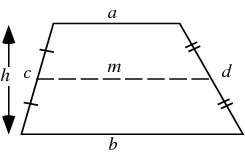How do you find the centroid of area of a trapezium?
 The area of a trapezoid can be determined by this function:
The area of a trapezoid can be determined by this function:
where a = top, b = base, and h = height
Area = 1/2 (a + b) h
The centroid lies on the median "m" between the base and the top.
If you split up the trapezoid into three triangles (1, 2, and 3), the first triangle has a centroid of (x1, y1) and an area of A1 and so on.
You can find the weighted average with this approach to find the total centroid coordinates (x, y):
x total centroid = (A1 * x1 + A2 * x2 + A3 * x3) / (A1 + A2 + A3)
y total centroid = (A1 * y1 + A2 * y2 + A3 * y3) / (A1 + A2 + A3)
First of all, it depends on whether you are using the American or English definition of “trapezium” — do you mean (a) a general quadrilateral (American), or (b) a trapezoid (English) As a general procedure, you would decompose the shape into triangles (or into two triangles and a rectangle, in the case of a trapezoid). The centroid of a rectangle is, obviously, the intersection of its diagonals. The centroid of a triangle is found at the concurrence of its three medians. Let’s say this trapezium were on the x-y plane. Decompose, and then find (a) the coordinates of the centroid of every triangle/rectangle (b) the area of each triangle/rectangle. Let’s say we divide the shape into three triangles, 1 & 2 & 3. The first one has a centroid of (x1, y1) and an area of A1, and similarly for the other two. We can do a weighted average x of total centroid = (A1*x1 + A2*x2 + A3*x3)/(A1 + A2 + A3) y of total centroid = (A1*y1 + A2*y2 + A3*y3)/(A1 + A2 + A3) That’s a very general approach. It’s


